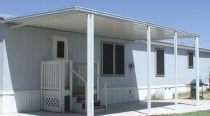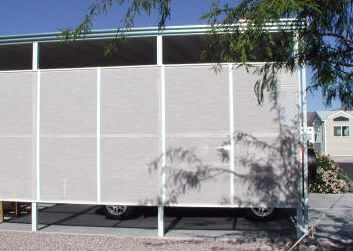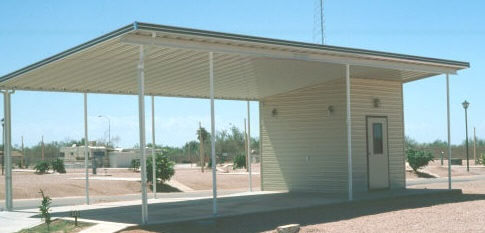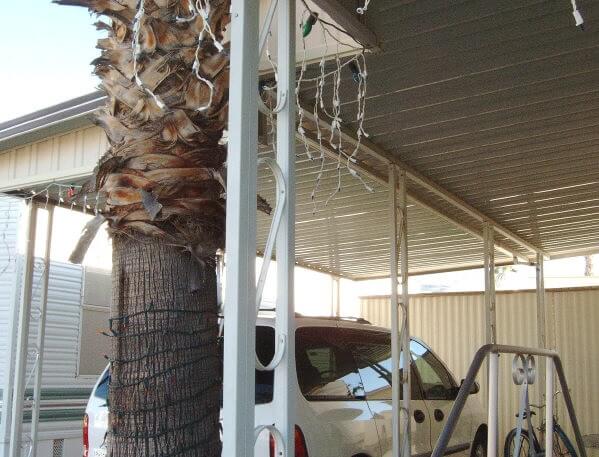Awning Questions and Answers
Helping You Do The Job Right
6. What are the different factors involved in wind loads and snow
loads?

Most aluminum
awnings are engineered in accordance with the International
Conference of Building Officials. If that is the case they will have an I.C.B.O. research report number. The primary factors in that report are
about using the right gauge material, the proper tributary spans, the proper
size footings for anchoring and the proper distance between columns. The
report rates the awnings according to live load per square foot, snow load and
wind speed. Some awnings are rated for a 10lb live load and 70mph wind
speed, while some may be rated at 30lb live/snow load and 100mph wind speed.
The major differences between the two are the panel thickness, the type of posts
used, the distance between posts and the way the posts are anchored. In
many cases an awning will go from a 10lb 70mph rating to a 20lb 80mph rating
with only the addition of an extra post or two. Any awning salesman or
awning company should have these reports and be able to help you attain any
desired rating you need for your weather conditions or city codes. If you
are attempting to get a permit for an awning you are building you will probably
need a copy of the I.C.B.O. report.
7. What can I mount to the sides of my awning for extra shade?
Shade screens work
well mounted to the posts of your awning. Aluminum
tubing can be used between the posts at the top and bottom of the screens and
the frames can be mounted to the tubes. Flex pan window awning material
adapts nicely to the sides of awnings. The window awning flex pans can be
mounted flat against the awning posts or at an angle as if it were over a
window. Boxed ends are nice additions to awnings. The same material
that is used for mobile home skirting can be used to add extra shade to awnings.
8. Does my awning have to attach to an existing structure?
Aluminum awnings
can be built either attached or freestanding. The
posts on a freestanding awning need to be made from heavy gauge steel and be
concreted in the ground at least 2'. Some companies make a thick 12'
square steel mounting bracket to allow posts to be placed on top of a concrete
slab. If a permit is required make sure your awning has the proper
engineering. The I.C.B.O. report will tell you all the ways a particular
awning can be properly anchored and still meet code requirements.
9. Can I attach one awning to another one?

There are two
ways to attach one awning to another. First is the awning
extension, used to extend the width of the awning. If the new portion of
awning is the same type material as the existing awning you would remove the
side fascia, install the new gutter using a gutter splice and lock the new
paneling into the existing. If the new material does not match the old you
cannot splice the gutters together properly and the pans will not lock together
properly. In this case you attach the new side fascia to the existing one,
seal the connected area, and continue building the new awning as a separate
unit. The second way of attaching awnings is called the piggyback.
If you want to change the projection of an awning from 10' to 20' a new awning
can be piggybacked to the existing one. The hanger of the new awning must
be firmly attached to the gutter of the existing awning. As the panels are
being installed short 3' pieces of flashing can also be used to cover over the
space between awnings. This flashing should be screwed into every panel
lock of both the old and new awning. Since there is no engineering for
this type of attachment if a permit is required you would need to dismantle the
awning and replace the panels with ones of the desired length.
10. If my concrete pad is off level will my awning be off level?
No, not if you cut your posts to fit your slab. When attaching the
hanger to the home make sure it is perfectly level. At the front of the
awning decide how much slope you want the awning to have and the proper length
of the first post. From there you would measure the slope of the concrete
and adjust the length of all the rest of the posts. I use a laser level to
find the exact slope of the concrete so my post lengths will always match the
concrete. Another way to do the same thing is to set the gutter up on saw
horses in the exact location it needs to be, next use shims and a carpenters
level to make the gutter level on the horses. Now measure down from the
gutter to the concrete at every post location. Those measurements will
tell you how to cut your posts to fit.
Awning Questions and Answers page 1
We would love to try and answer any other questions you may have. You can always
reach me here.
In the Mesa Arizona area give me a call for a free awning estimate.
CR Shades - Dennis Gourley - Sales - 480-935-2848
top of Awning Questions and Answers



